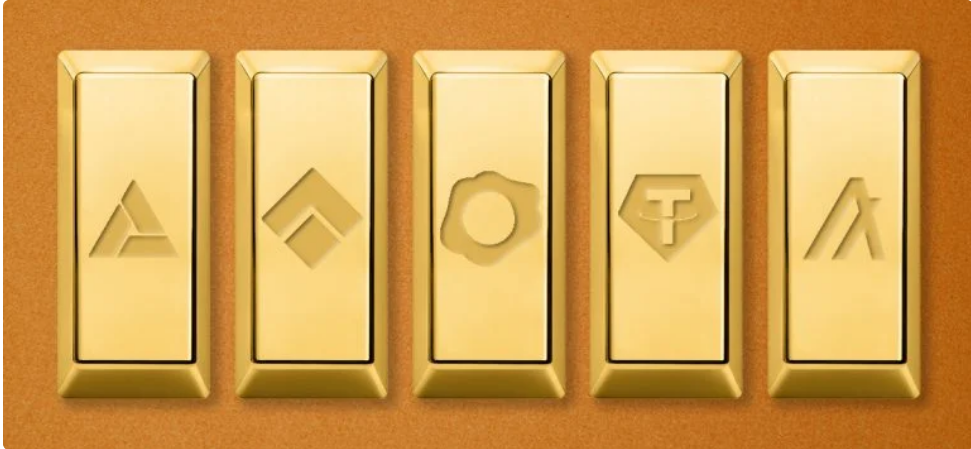Gold-backed cryptocurrency tokens have emerged as a new, commodity-pegged stablecoin in the crypto market. But as many gold bugs turn to these innovative alternatives, many are unsure where to start.
So, what are the top five gold-backed cryptocurrency tokens?
Key Takeaways
- Identifying top, gold-backed cryptocurrencies is much like evaluating traditional gold suppliers.
- Crypto Briefing’s selection ranges from the new to the old, and spans around the world.
- The greatest advantage of digital versions of gold is their ability to be divisible and transferred in any amount.
Perth Mint Gold Token (PMGT)
The Perth Mint Gold Token (PMGT) is backed by gold in the Western Australian government’s Perth Mint. The purity and weight of the gold are guaranteed by the government, with the mint issuing digital gold certificates through the GoldPass app.
Those certificates are then used to back PMGT tokens. Each token is backed by the certificates on a 1:1 ratio and is traded on exchanges like KuCoin.
The tokens trade on exchanges such as KuCoin. With zero fees for custody, storage, and insurance, PMGT tokens are cost-effective gold assets and a competitive alternative to traditional gold products, like gold ETFs and banked gold transfers. PMGTs are also fungible with traditional gold markets.
Operated by InfiniGold, the amount of gold backing each PMGT can be verified in real-time against the balance of GoldPass accounts published by the Perth Mint. That means that holders do not have to wait for monthly audits to see that the tokens are 100% fully-backed.
InfiniGold CEO Andreas Ruf spoke of the value of backing tokens with physical government-verified gold bullion:
“As The Perth Mint is the largest refinery of newly mined gold in the world, we’ve got an unprecedented depth of liquidity to bring to the market with the Perth Mint Gold Token. We haven’t simply purchased a couple of gold bars, put them in a vault, and then tokenized them. We can tap into billions of dollars worth of gold stored at The Perth Mint.”
PMGT holdings are fully redeemable for physical gold, though liquidity is minimal.
DigixGlobal (DGX)
DGX gold-backed cryptocurrency tokens are provided by Singapore-based DigixGlobal, with each token representing 1 gram of gold held in vaults in Canada and Singapore. The Bullion Association fully accredits and insures the vaults.
DGX tokens effectively make gold bars divisible, redeemable, and transferable through merely buying and selling the tokenized digital representations. The creators of DigixGlobal designed this process to digitization democratize access to gold,
There is a 1% fee to exchange the tokens for physical gold, and the company assumes the demurrage fee, which is the cost of storing the gold. Digix Gold tokens are very thinly traded and have a market cap of just under $6 million.
PAX Gold (PAXG)
Paxos, a New York State Trust Company, issues PAXG tokens that are backed by one fine troy ounce (t oz) of a 400 oz London Good Delivery gold bar stored in Brink’s vaults.
The underlying gold is held in custody by Paxos, with full ownership rights belonging to the token holder.
Paxos is bound by U.S. law to back PAXG tokens with mandatory capital reserves. The creators of Pax Gold launched the token as an ERC-20 token on the Ethereum blockchain. PAXG tokens can be traded worldwide, and are redeemable for LBMA-accredited London Good Delivery gold bars.
PAXG gold-backed cryptocurrency tokens have a market cap of around $32 million.
Tether Gold (XAUT)
The largest USD-backed stablecoin issuer, Tether, has released a gold-backed crypto token XAUT. Formally offered by TG Commodities Limited, each XAUT is backed by one troy fine ounce of gold on a London Good Delivery gold bar.
Tether’s gold reserves are held in a Swiss vault, and token holders can look up the serial number of their assigned gold bars via Tether’s website. Tether also allows investors to take physical delivery of their gold or redeem for cash.
The XAUT gold-backed cryptocurrency tokens reside on the TRON and Ethereum blockchains. Users can track transactions on block explorers like Etherscan.
Currently, XAUT has a market cap of around $50 million. Bitfinex was the first exchange to list XAUT.
Meld Gold by Algorand
Australian startup Meld Gold has partnered with blockchain protocol Algorand, to create a decentralized gold token.
The tech company created a digital platform that plans to change the way gold is bought and sold. Meld Gold will integrate into the existing gold supply chain to deliver faster trading and settlement of gold through tokenization.
The creators designed the platform so that investors can transact in both physical gold and digital gold tokens. Michael Cotton, Director of Meld Gold, spoke of the advantages of the platform to those already in the gold industry, from mints, refineries, dealers, to vaults:
“This brings transparency to the gold market for the first time by directly connecting buyers and sellers on a digital platform. Currently, the gold market provides limited access and little visibility into its supply chain, which makes trading time-consuming, expensive, and inefficient.”
Meld Gold’s offering is slightly different. According to Peter August, the CEO of Melbourne Mint, Meld Gold wants to use blockchain technology “to not just emulate but improve the actual gold market.”
Having said that, the benefits are the same: enhanced efficiency, transparency, and accessibility. Henrik Andersson, Chief Investment Officer of Apollo Capital, a leading Australian crypto fund, said:
“Essentially, Meld is creating a cryptocurrency on-ramp for the gold industry and vice-versa: the entire gold market will now be connected to the retail investing industry. The potential impact is huge: this is just the beginning of the blurring of the lines between traditional and digital finance.”
The Benefits of Gold-Backed Cryptocurrency Tokens
Holders of gold-backed cryptocurrency tokens enjoy being able to own gold while avoiding the drawbacks associated with physical gold, including storage costs and limited accessibility.
However, gold-backed stablecoins are still a small component of the pegged cryptocurrency market, with USD-backed stablecoins remaining a much larger part of the ecosystem.














